You’ll achieve unprecedented precision and eliminate costly mistakes when you choose CAD for metal clay jewelry design. The technology calculates exact material needs, reduces waste of expensive metal clay, and creates complex 3D models with measurements impossible through hand-forming. You’ll streamline your workflow with rapid design iterations, instant modifications, and seamless 3D printing integration for accurate prototypes. CAD guarantees consistent quality across multiple pieces while transforming your artistic vision into professional masterpieces with enhanced detail accuracy and creative possibilities.
Enhanced Precision for Complex Metal Clay Structures
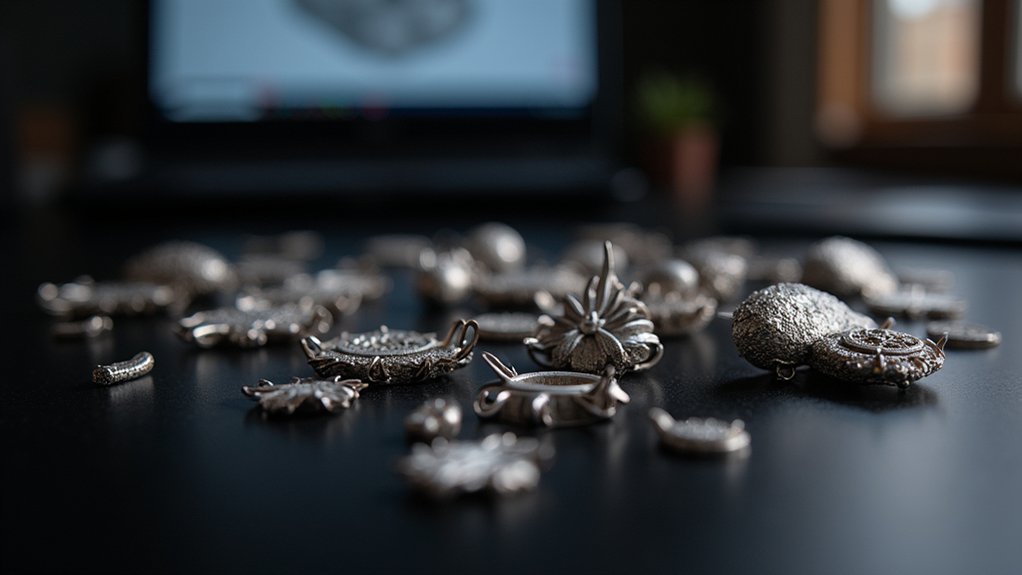
When you’re designing intricate metal clay jewelry, CAD technology becomes essential for achieving the precision that hand-forming simply can’t match.
You’ll find that CAD allows you to create complex 3D models with exact measurements and dimensions, eliminating the guesswork that often leads to production errors.
The software’s ability to simulate metal clay’s physical properties means you can visualize how your material will behave during firing before you even touch the clay.
This foresight lets you adjust jewelry designs proactively, preventing costly mistakes and material waste.
You’ll also benefit from CAD’s precision when creating multi-part pieces.
The accurate measurements guarantee perfect fitting and assembly, resulting in professional-quality finished products that showcase your craftsmanship at its finest.
Time-Saving Benefits in Metal Clay Design Workflow
You’ll dramatically reduce your design timeline when CAD software replaces traditional hand-drawing and physical prototyping methods for metal clay jewelry.
The software’s digital rendering capabilities let you create rapid design iterations, allowing you to test multiple variations and make improvements without touching any clay.
This streamlined production process means you can move from initial concept to final design much faster, freeing up more time for actual crafting and client work.
Rapid Design Iterations
Since traditional jewelry design methods can consume weeks or even months moving from initial sketches to finished prototypes, CAD software transforms your metal clay workflow by enabling rapid iterations that compress this timeline dramatically.
You can experiment with multiple design variations in hours rather than days, testing different approaches without wasting materials. This acceleration happens through three key advantages:
- Instant modifications – You’ll adjust dimensions, textures, and structural elements with simple commands.
- Real-time visualization – You can immediately see how changes affect your overall design.
- Version control – You’ll maintain multiple design iterations without losing previous work.
Your CAD designs streamline manufacturing processes by producing precise digital files ready for production.
These rapid iterations help you identify potential issues early, preventing costly rework while expanding your creative possibilities in metal clay jewelry development.
Streamlined Production Process
Beyond accelerating your design phase, CAD software revolutionizes your entire metal clay production workflow by eliminating traditional bottlenecks that slow jewelry creation. You’ll experience seamless shifts from concept to finished piece through integrated manufacturing processes.
| Traditional Method | CAD Process | Time Savings |
|---|---|---|
| Manual sculpting | Digital modeling | 60-70% faster |
| Physical revisions | Virtual modifications | Instant changes |
| Material guesswork | Precise calculations | Zero waste |
Your CAD process enables precise material requirement calculations, eliminating costly waste and optimizing resource allocation. When you integrate CAM technology for 3D printing, you’ll glide effortlessly from design to manufacturing without manual interventions. This streamlined approach transforms your production timeline, allowing you to focus on creativity while technology handles the technical complexities of bringing your metal clay jewelry designs to life efficiently.
Cost-Effective Material Usage and Waste Reduction
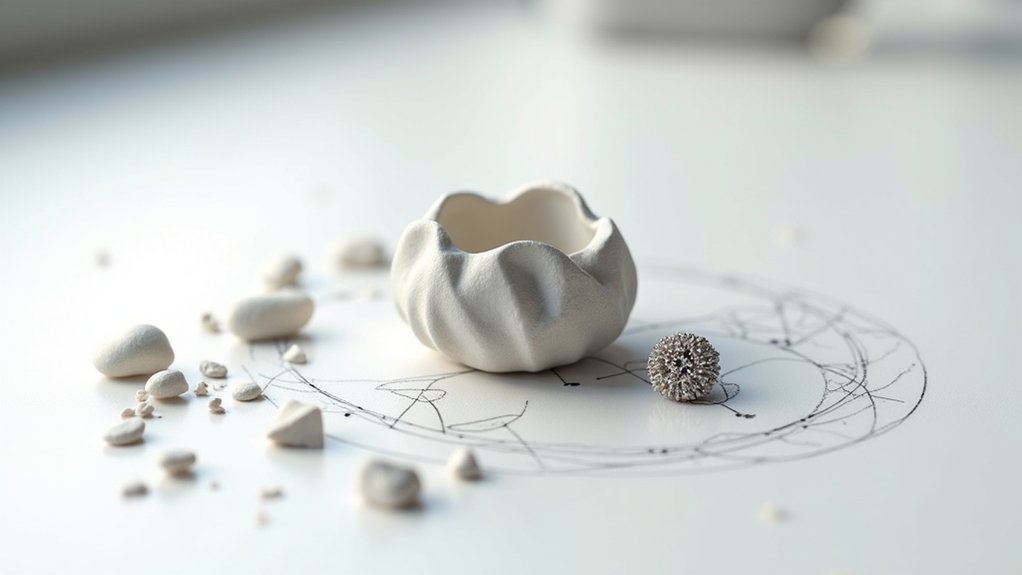
When you’re working with metal clay, precision in material calculations becomes essential for your project’s profitability.
CAD software enables you to determine exactly how much clay you’ll need before you even touch the material, eliminating the guesswork that often leads to expensive overages.
You’ll find that this precise planning approach greatly reduces waste while maximizing the value you get from every gram of metal clay.
Precise Material Calculations
While traditional metal clay jewelry making often involves guesswork and material overages, CAD software transforms your approach by delivering precise calculations of exactly how much material you’ll need for each piece.
This technological advantage provides three key benefits for your jewelry-making process:
- Exact weight and volume predictions – You’ll know the precise amount of metal clay required before starting production.
- Cost optimization – Accurate calculations eliminate unnecessary material purchases and reduce overall expenses.
- Enhanced material efficiency – Digital modeling lets you identify the most economical use of resources for each design.
Minimizing Clay Waste
Since metal clay ranks among the most expensive jewelry-making materials, minimizing waste directly impacts your project’s profitability and sustainability.
CAD software enables you to calculate exact material requirements before production begins, eliminating guesswork that leads to excess usage. You can simulate your design’s volume digitally, determining precisely how much clay each piece needs.
The software’s modification capabilities let you refine designs before physical creation, preventing costly mistakes that result in discarded pieces.
You’ll create intricate designs that maximize clay effectiveness, utilizing every portion of material for complex shapes without requiring additional resources.
CAD also facilitates efficient nesting of multiple pieces, optimizing clay usage across entire production runs and considerably reducing overall material costs while maintaining design quality.
Advanced Visualization Capabilities for Metal Clay Projects
How can you truly envision your metal clay jewelry design before committing precious materials to the creation process?
CAD software revolutionizes your design workflow by providing advanced visualization capabilities that transform how you approach metal clay projects. You’ll create intricate 3D models that capture every detail, allowing thorough examination before building your physical model.
CAD’s visualization advantages include:
- Multi-angle viewing – Rotate and examine designs from every perspective to understand how your finished piece will look and function.
- Photorealistic rendering – Generate high-quality images perfect for client presentations and marketing materials.
- Rapid iteration capability – Modify designs instantly to experiment with different approaches and refine intricate details.
This technology eliminates guesswork, reduces costly mistakes, and enhances your creative experimentation process considerably.
Seamless Integration With 3D Printing for Prototypes
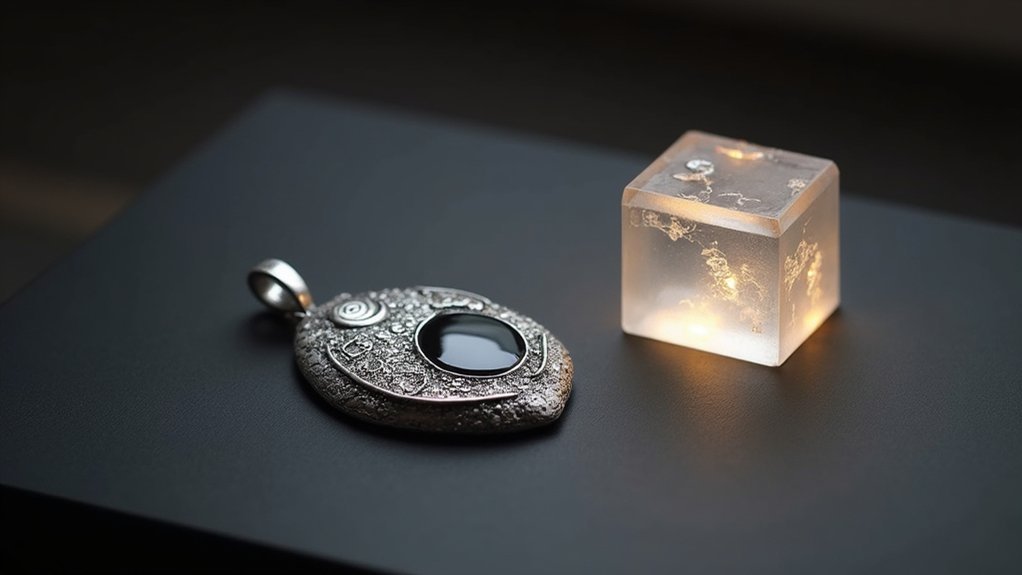
When your CAD design reaches completion, you’ll discover that modern software creates a direct bridge to 3D printing technology, eliminating traditional barriers between digital concepts and physical prototypes.
Your CAD models transfer seamlessly to 3D printers, producing accurate test pieces that mirror your exact specifications. This integration dramatically reduces development time compared to traditional handcrafting methods.
CAD-to-3D printer integration eliminates traditional barriers, producing accurate prototypes that dramatically reduce development time compared to conventional handcrafting methods.
You’ll visualize and test designs before committing to final production, minimizing expensive revisions.
Complex geometries that would challenge conventional techniques become achievable through this digital workflow. The rapid prototyping capability allows you to iterate quickly, modifying designs based on physical testing and feedback.
Your prototypes serve as precise templates, ensuring the final metal clay jewelry matches your original vision while streamlining the entire creative process.
Consistent Quality Control Across Multiple Pieces
While traditional handcrafting methods introduce natural variations between pieces, CAD technology transforms your jewelry production by delivering identical results across every iteration.
You’ll achieve unprecedented consistency in your metal clay jewelry through precise 3D modeling that maintains uniform dimensions and characteristics.
CAD files become your reliable reference point for quality control, enabling you to:
- Compare physical outputs against digital designs to verify all pieces meet specified standards
- Implement consistent design features like stone settings and intricate patterns across multiple items
- Reduce human error during production while maintaining high quality in larger runs
This enhanced precision translates to improved fit and finish, allowing you to replicate successful designs quickly while delivering professional-grade jewelry that meets exact specifications every time.
Creative Freedom for Intricate Pattern Development
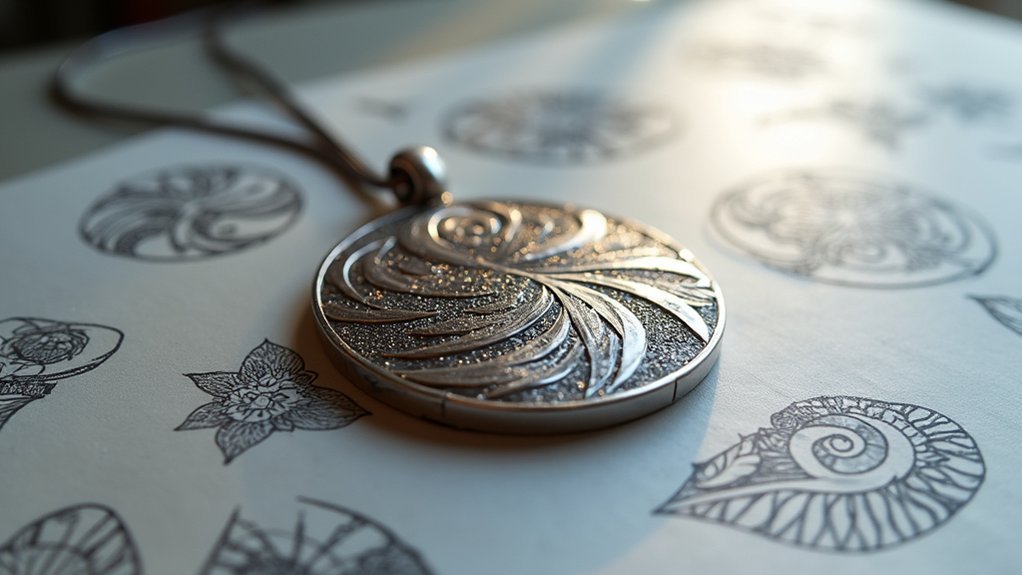
Because CAD software eliminates the physical constraints of hand-forming metal clay, you’ll reveal creative possibilities that were previously impossible to achieve through traditional methods. Your intricate patterns can now feature complex geometries and elaborate details that would challenge even the most skilled hands.
| Traditional Method | CAD Software |
|---|---|
| Limited by hand dexterity | Unlimited geometric complexity |
| Time-consuming iterations | Instant pattern modifications |
| Difficult replication | Perfect pattern consistency |
| Manual calculations | Precise material optimization |
You’ll visualize every detail before production begins, ensuring your creative potential isn’t compromised by technical limitations. CAD’s 3D modeling capabilities let you iterate endlessly, exploring unique combinations and variations. You can replicate successful designs while experimenting with new elements, transforming ambitious concepts into achievable reality.
Professional-Level Results for Metal Clay Artisans
CAD software elevates your metal clay creations from hobbyist experiments to professional-quality masterpieces that rival commercially manufactured jewelry.
CAD software transforms amateur metal clay projects into professional masterpieces that compete with commercial jewelry standards.
You’ll achieve precision and consistency that manual techniques simply can’t match, transforming your artistic vision into flawless reality.
The manufacturing process becomes remarkably refined when you integrate CAD technology:
- Enhanced Detail Accuracy – You’ll capture intricate elements that would deteriorate during traditional hand-forming methods.
- Consistent Reproduction – Your designs maintain identical specifications across multiple pieces, ensuring professional uniformity.
- Superior Mold Quality – 3D-printed wax models preserve every nuance of your original concept.
You’ll eliminate the guesswork and trial-and-error cycles that plague conventional approaches.
CAD software provides the technical foundation needed to deliver gallery-worthy pieces that demonstrate true craftsmanship and meet professional industry standards.
Frequently Asked Questions
What Is the Best CAD Software for Jewelry Design?
You’ll find Rhino and Matrix are top choices for professional jewelry design, offering advanced 3D modeling capabilities. If you’re starting out, TinkerCad provides user-friendly tools, while RhinoGold delivers sophisticated features for intricate work.
What Does CAD in Jewelry Mean?
CAD in jewelry means Computer-Aided Design – you’ll use specialized software to create detailed 2D or 3D models of jewelry pieces. It enhances your precision, creativity, and lets you visualize designs before production.
Is Autocad Used for Jewelry Design?
You can use AutoCAD for jewelry design, but it’s not ideal. You’ll find specialized software like Rhino or Matrix better suited for jewelry’s complex 3D modeling and organic shapes requirements.
What Are the Requirements for Jewellery CAD?
You’ll need a powerful computer costing around $2,500, CAD software like Rhinoceros starting at $1,000, basic math knowledge, and understanding of material properties. Expect significant time investment for mastery.
In Summary
You’ll revolutionize your metal clay jewelry work by embracing CAD technology. You’re gaining precision that’s impossible with traditional hand-forming methods, while you’re cutting material waste and design time considerably. You’ll create professional-quality pieces with consistent results, and you’re opening up creative possibilities for intricate patterns that’d otherwise be unachievable. With 3D printing integration, you’re prototyping faster and more accurately. CAD isn’t just changing metal clay work—it’s elevating your entire artistic process.

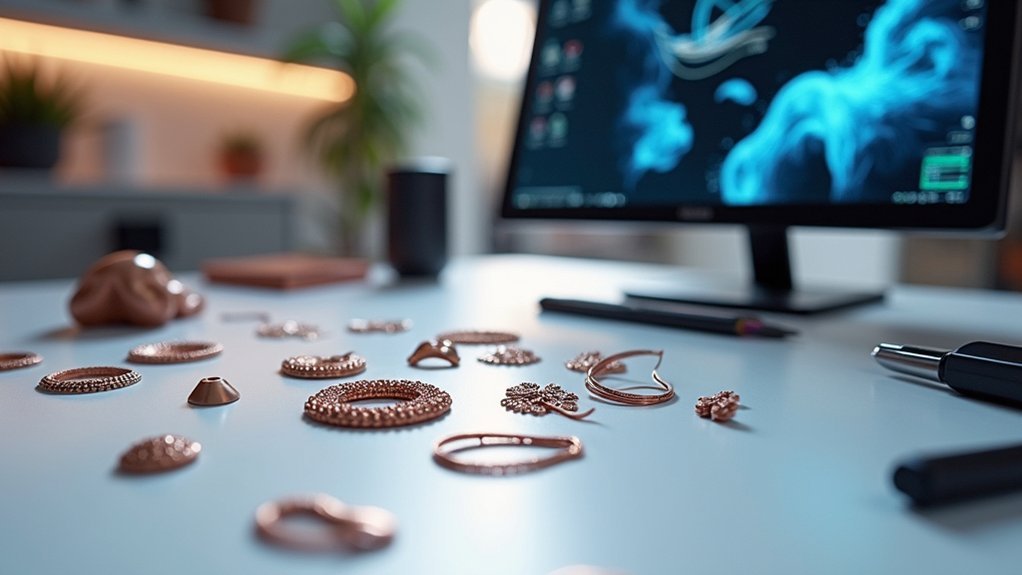



Leave a Reply